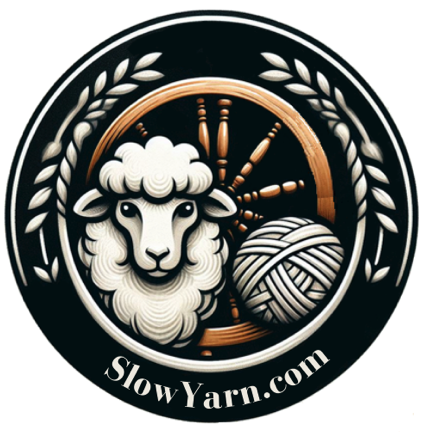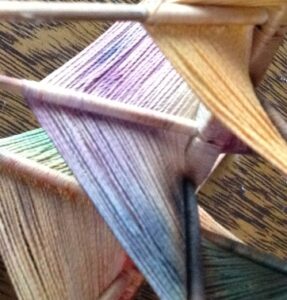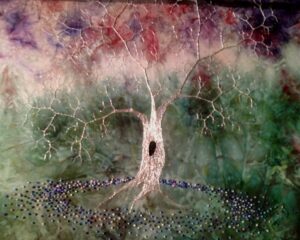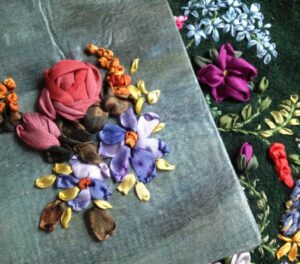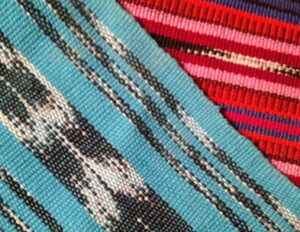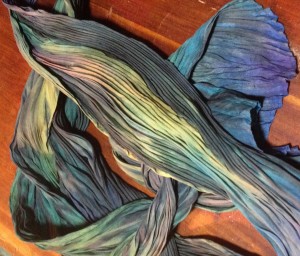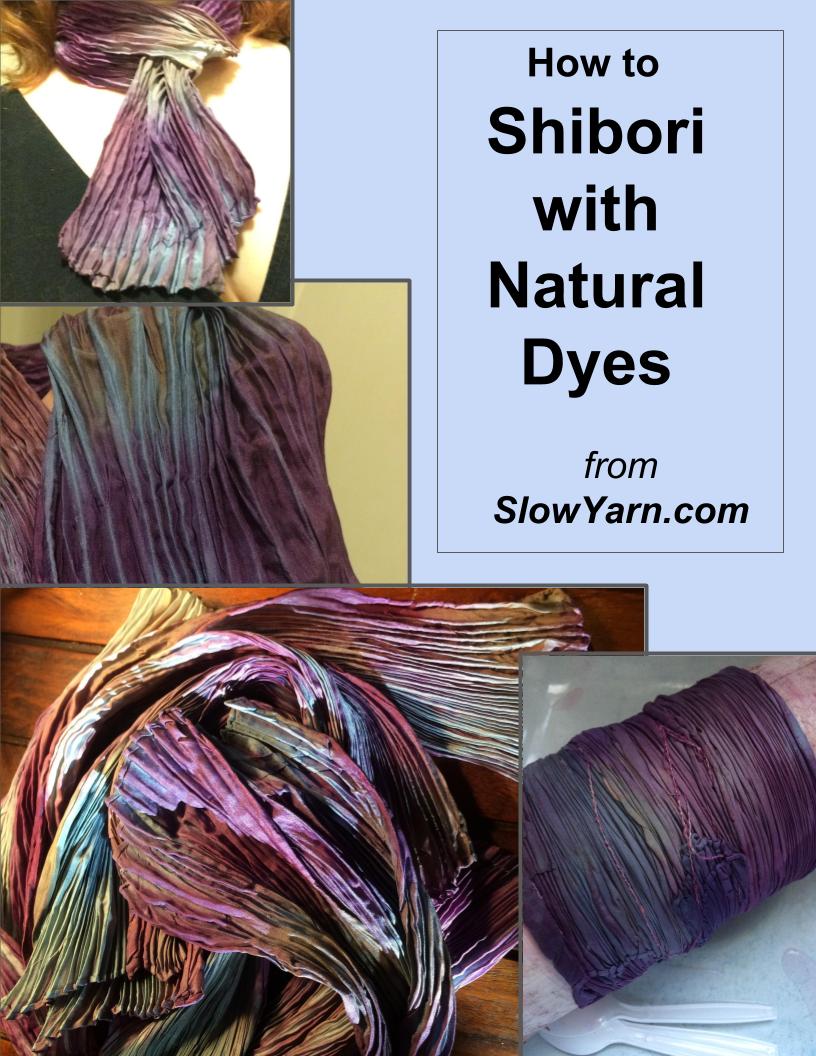Hand Dyeing
Any dyeing done by hand in small batches is considered “hand-dyed.” Time has been taken by an individual who has an artistic vision of how they want the yarn or fabric, and they have considered its destined final use. Hand dyeing fabric can be the basis for quilting or sewing that is so completely an artistic expression of the maker they may never want to use purchased dyed fabric again. There is something so deeply appealing about hand dyed fiber. The irregularity of color is an aesthetic relief from the solid colors and evenness of commercial dyeing. Because the dyer took the time to create pleasing results on hand dyed yarn or fabric, commercially dyed fiber can’t hold a candle to its beauty.
Variegated Dyeing

Hand dyed habotai silk fabrics
SlowYarn.com
Because the end product can be controlled so well with hand dyeing, color can be applied like paint to canvas. Any use of color that can be imagined can be applied to yarn, fleece or fabric. Here are some of the more common applications of dye for the slow fiber artist. These uses of color keep in mind the end product that will be created using the yarn or fabric that is being dyed.
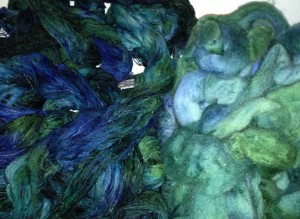
Hand-Painted
Yarn can be hand painted, using a brush or spray, applying color in very distinct areas. Hand-painted yarns can paint a picture if the application is done correctly. This method is usually done directly on warp threads already on the loom. Hand painting can also be produced precisely placed color patches on yarn for knitting. On fabric, a dye can be applied just like watercolor paints, with a resist outline to prevent uncontrolled bleeding of color. Some of the most elegant hand painted fabrics are done on silk.
Stripes
Stripes dyed in yarn can be used to great effect. Socks, for instance, can have stripes carefully dyed to create bands of color around the ankle. Larger areas of a single color, changing only after many yards might be better for a sweater. If the stripes change too fast, once they are knitted they may disappear altogether and create a muddied appearance on the fabric. All of that can be controlled by the dyer with careful planning.
Shading
It is possible to get a continuous grade of color or shade from dyeing yarn. A sweater, for instance, that is pale around the torso, but gets darker and darker further up until there is a deeply colored stripe around the chest– this would be an example of gradated dyeing or shading. Dyeing can be controlled to make this kind of shading. Mixing dyed shades in the spinning process can also make this kind of gradation.
Resist Dyeing
Any number of interesting variations on tie-dyeing can be used for both yarn and fabrics. The ever-popular hippy tie-dye shirts in their characteristic brilliant colors are only the beginning. Tie-dyeing is also known as “resist dyeing.”
Any time the dye is prevented from penetrating the fiber it is a form of resist dye. In fabric painting, a wax resist might be used, as in batik, or a gutta or paste resist might be drawn onto fabric to prevent dyes from bleeding out of a defined area.
Rubber bands, string, or grasses might be bound around fiber or fabric as it is submerged into a dye vat, and no color will penetrate where the tie is.
Here are examples of a few of the most popular resist dyeing techniques:
Tie-Dye
Most people are familiar with the brilliant colored t-shirts made with this resist technique. The tie-dye look represents an era and a culture which is still as vibrant as its t-shirts! By tying knots in fabric, or wrapping it tightly with a resist, such as string, yarn, plastic wrap, or rubber bands, the amount of color present in an area of the fabric can be carefully controlled.
Ikat
This form of resist dye uses skeins of yarn, often already measured out into hanks ready to warp for the loom. Portions of the yarn are wrapped tightly with string, plastic, or tape. The yarn is so tightly bound that dye cannot get past the binding and into the yarn in those places. The yarn is then dyed, rinsed and the dye set. After the dye is set, the bindings are unwrapped and the yarn is allowed to dry thoroughly before warping the loom. Tiny variations in tension on the loom result in a ragged edge to the white patches. This is a very common hand dyeing technique in Central America.
Shibori
Another form of resist dye involves a controlled wrinkling of fabric, resulting in tiny stripes which resist the penetration of dyes. When done on silk, the wrinkles are set into the fabric along with the setting of the color. This fabric is a visual feast of color and texture.
Silk is preferred for this method of dyeing, because of its property of holding the creases that dried in. The pleated texture adds appeal both in a tactile sense and visually. With color deep in the crevasses, shibori almost looks iridescent with depth and light.
Often used with natural Indigo dye, the thread resist technique makes an intricate pattern of white on blue. Threads are sewn into the fabric and gathered taught, or gathered around the outside of a fabric that is wound around a stick or rock.
If you would like to read more about Shibori with natural dyes, click here.
Natural Dyeing
One of the most rewarding and exciting methods of hand dyeing fabric or yarn is to use natural materials as the dye source. Plants are the most common of these, but dirt and bugs are also common sources of natural color. Cochineal. one of the oldest sources of the pink to red range of colors comes from the body of a special variety of beetle. Mordants, the metallic salts which help natural dyes saturate the fibers, come from various metal ore. Pigments, which are applied differently than dyes, come from various colors of earth or are extracted from certain plants, and have colored fabric or thread for a very, very long time.
Scientists discovered a cave in what is modern-day Georgia which had flax fibers dyed black, gray, pink, and turquoise. One of the easiest ways to get black on fiber is to use iron-rich peat bog soil. This is the same type of bog which preserved hundreds of corpses from ancient Europe, all blackened but with skin and clothing intact.
Click here to read about natural dyeing with bloodroot.
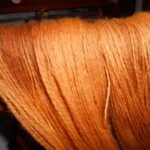
Comments are always welcome here at SlowYarn! Tell us what you think, share your ideas, or comment on the content. Or you can contact me directly at Kelley@SlowYarn.com.
Thanks!
–Kelley
Copyright © 2013- 2023 Kelley Adams. All rights reserved.
All text, photos, and graphics are the property of Kelley Adams.
